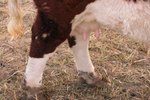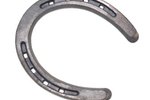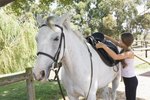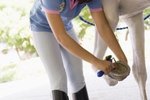Getting rid of a corn on a dog's footpad is relatively simple. The problem is that excising the corn often just solves the problem temporarily. In most cases, this painful growth consisting of dead skin cells comes back before long.
Canine Corns
Corns are formally known as keratomas, and the condition is also referred to as orthokeratotic hyperkeratosis or footpad keratosis. Although other dogs may develop corns, greyhounds are the most affected breed. Other types of sighthounds may also suffer from corns, which appear as hard, round growths on the digital footpad.
Corn Symptoms
If you notice your dog having problems when walking on hard flooring or other firm surfaces, take a good look at his paw pads. If you notice a hard mass, push it gently but firmly. If your dog reacts with pain, it's likely that the corn is the cause of his lameness. Other signs include longer claws on the foot involved, indicating the dog is moving in a way to compensate for possible pain.
Why Corns Develop
Corns may develop on your dog's feet for several reasons. These include:
- a foreign body in the footpad
- a cut or injury to the pad, causing fibrosis
- or papilloma virus infection.
Greyhounds lack the fatty, thick layer found in the pads of other breeds, making them more susceptible to corn formation from the constant pressure on their feet. Their paws are also narrower and longer than typical canine feet, with pads closer together. Sex or weight doesn't appear to affect the likelihood of corn formation in greyhounds.
Corn Treatment
Surgical removal is usually the initial step in corn treatment. Because the corn tissue is dead, there is no blood involved. After the surgery, the vet places a pressure relief bandage on the foot. The bandage elevates the footpads so pressure doesn't interfere with healing. When you take your dog out for his constitutionals, place protective booties on his feet. Once his foot heals, you may want to use therapeutic boots on your dog whenever he goes for a walk.
If you're lucky, removing the corn solves the problem for good. In many cases though, the corn reappears within six months of surgery. Since the corn often extends deep into the footpad, more extensive and invasive surgery may eradicate the corn. In a worst-case scenario, your vet can amputate the toe on which the corn is located.
Tips
Some vets have had luck treating corns by injecting fat or silicone into the footpads, creating cushioning in greyhounds where there was none.
Writer Bio
Jane Meggitt has been a writer for more than 20 years. In addition to reporting for a major newspaper chain, she has been published in "Horse News," "Suburban Classic," "Hoof Beats," "Equine Journal" and other publications. She has a Bachelor of Arts in English from New York University and an Associate of Arts from the American Academy of Dramatics Arts, New York City.





